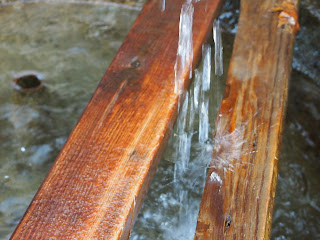 |
| At a Vermont roadside spring, water is routed via pipe |
 |
| to a "granite bowl that must once have served as a watering trough for horses." |
Continue reading about Vermont's roadside springs at "Roadside Springs Eternal: But Can You Drink the Water?" by Jon Vara
(scroll down for article)
A few years ago my friend Martha led a small group spiritual experience exploring "Living Water." She set up a small bubbling fountain in a large bowl on the table where we gathered, with rocks and more. Like me, she thrives with tangible "prompts" for prayer and reflection. One of our first activities was to each write our own prayer asking for living water, a prayer to use regularly in our individual prayer times during the few weeks we were meeting. Used to praying with it, when our month or so of meetings ended, I chose to continue praying what I had written when I say "Midday Prayer" from A New Zealand Prayer Book. (Given my problems with linear time, I use "midday" very loosely.)
Because we raised sheep when I was growing up, I find it natural even now to think in terms of sheep and Shepherd when I pray. (And, yes, the lambs did appear to play "Shepherd of the Mountain" on their mothers' backs.) You might prefer images such as musicians and Conductor, swimmers and Lifeguard, subjects and Queen, or quarks and Source for your own prayers.
Easing into asking for living water...
Jesus, brother, guide: lead me.
I am your sheep who wanders when the others rest, and wants to rest when it is time to move on. You gave me your living water in baptism and it has flowed through me.
But now I am an old ewe, too often too sure of her own wisdom, too drained by lambs who have needed me or played Shepherd of the Mountain on my back, too toughened by thickets of thorns and the snapping teeth of reality, to want the work, the changes, the uncertainty, the engagement that your living water within me might involve.
I wish you would just let me be, but I don’t want to be still lying here, seeing your back in the distance, when the stream swells and rises, the dark woolly clouds descend.
Do you have any “Good Shepherd” prayers you use?
Or prayers you say simply because of when or where you first used, or composed, them?








